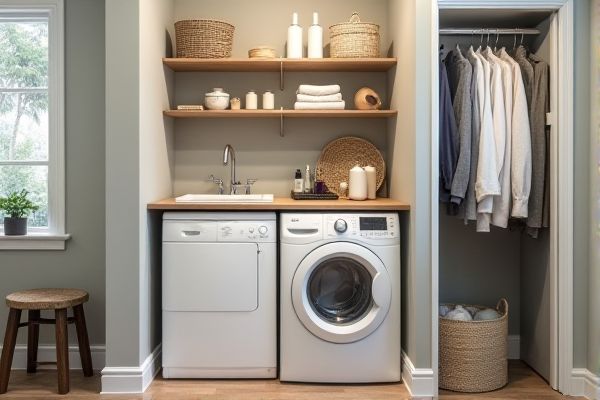
A utility closet is designed to store cleaning supplies, tools, and laundry essentials, making it ideal for organizing your laundry-related items efficiently, while a linen closet primarily holds towels, sheets, and other fabric items for household use. Discover how choosing between a utility closet and a linen closet can optimize your laundry space and simplify your daily routine by reading the rest of the article.
Table of Comparison
| Feature | Utility Closet | Linen Closet |
|---|---|---|
| Primary Use | Storage for cleaning supplies, tools, and laundry equipment | Storage for towels, sheets, and laundry essentials |
| Location | Near laundry area, kitchen, or garage | Near bedrooms or bathrooms |
| Space | Larger, accommodates bulky items and appliances | Smaller, focused on folded linens and light items |
| Storage Features | Shelves, hooks, compartments for cleaning tools | Adjustable shelves for linens and laundry products |
| Organizational Focus | Cleaning efficiency, equipment accessibility | Neat linen storage, easy access for laundry tasks |
| Common Items Stored | Vacuum cleaners, brooms, mops, detergents | Towels, bed sheets, pillowcases, laundry detergents |
| Ideal For | Maintaining cleaning tools and laundry supplies | Organizing and storing clean laundry essentials |
Understanding Utility Closets and Linen Closets
Utility closets are designed for storing cleaning supplies, tools, and laundry essentials like detergents and ironing boards, optimizing your laundry routine's efficiency. Linen closets primarily house towels, sheets, and blankets, providing organized storage for clean laundry and household fabrics. Understanding the distinct purposes of utility and linen closets helps you maximize space and functionality in your laundry area.
Primary Functions: Utility vs. Linen Closets
Utility closets primarily store cleaning supplies, tools, and laundry equipment, facilitating household chores and maintenance, whereas linen closets are dedicated to organizing towels, bedsheets, and other fabric essentials for easy access and storage. The utility closet often contains mops, brooms, vacuum cleaners, and sometimes extra laundry detergent, supporting diverse cleaning tasks beyond laundry. Linen closets focus on neatly folded textiles, emphasizing accessibility and preserving the quality of linens for daily use.
Storage Capacity for Laundry Essentials
A utility closet typically offers greater storage capacity for laundry essentials, accommodating larger items like detergent bottles, cleaning supplies, and bulkier tools such as brooms or vacuum cleaners. In contrast, a linen closet is designed mainly for storing folded fabrics and smaller laundry items, making it less versatile for bulky or varied laundry supplies. Evaluating your specific storage needs can help determine which closet type best organizes and maximizes space for your laundry routine.
Organization Strategies for Laundry Supplies
Utility closets typically offer more space and flexibility for organizing laundry supplies, with adjustable shelving and hooks ideal for storing bulky items like detergent bottles, cleaning tools, and ironing boards. Linen closets prioritize compact, uniform storage solutions such as stackable bins, labeled baskets, and moisture-resistant containers to keep towels and sheets tidy while accommodating smaller laundry essentials. Employing clear, categorized containers and dedicated zones within either closet type maximizes functionality and streamlines laundry routines.
Accessibility and Convenience for Laundry Tasks
A utility closet is typically designed for easy access to laundry essentials like detergents, cleaning tools, and ironing supplies, making laundry tasks more efficient. Linen closets often prioritize storage of towels and bedding, which can limit their convenience for daily laundry needs. Optimizing a utility closet layout enhances workflow and reduces time spent searching for supplies during laundry routines.
Space Optimization Tips for Small Laundry Areas
Utility closets serve multiple storage functions, making them ideal for small laundry areas by housing cleaning supplies, tools, and laundry essentials in a compact space. Linen closets are designed primarily for storing towels and bedding, but incorporating adjustable shelving and pull-out baskets can enhance organization and free up valuable space. Using vertical storage solutions and multi-functional organizers in both closet types maximizes efficiency and keeps laundry rooms clutter-free.
Customization Options for Laundry Storage
Utility closets offer extensive customization options for laundry storage, including adjustable shelving, pull-out hampers, and built-in ironing boards tailored to fit unique space requirements. Linen closets typically provide standardized shelving primarily for towels and sheets, with limited adaptability for bulky laundry items or specialized equipment. Optimizing laundry organization benefits from utility closet features designed to accommodate detergents, cleaning supplies, and sorting bins, enhancing overall efficiency.
Safety and Ventilation Considerations
A utility closet designed for laundry use typically offers enhanced ventilation and safety features such as exhaust fans and proper clearance for dryers to prevent overheating and reduce fire risk. Linen closets, often enclosed with limited airflow, may accumulate moisture and lint, creating potential hazards for mold growth and reduced appliance efficiency. Ensuring your laundry area has adequate ventilation and complies with safety standards is crucial to protect your home and maintain optimal appliance performance.
Cleaning and Maintenance Differences
Utility closets are designed for heavy-duty storage, making them ideal for housing large cleaning supplies and equipment, while linen closets are better suited for storing towels, sheets, and delicate fabrics that require less frequent access. Utility closets often require more frequent cleaning and organization due to exposure to dirt, chemicals, and bulky tools, whereas linen closets typically need maintenance focused on dusting and preventing moisture buildup to preserve fabric quality. Your cleaning routine will differ significantly depending on which closet you use for laundry purposes, ensuring efficiency and longevity of stored items.
Choosing the Best Closet Type for Your Laundry Needs
Choosing the best closet type for your laundry needs depends on available space and storage requirements, with utility closets offering versatile storage for cleaning supplies, tools, and laundry essentials, while linen closets specifically accommodate towels, sheets, and linens. Utility closets often feature adjustable shelving and hooks, making them ideal for stowing bulky detergent containers, ironing boards, and other laundry equipment. Linen closets prioritize organized stacking and easy access to folded laundry items, making them perfect for households focused on keeping bedding and towels neatly arranged.
 homyna.com
homyna.com